Almost 150 years ago, Kristian Birkeland glimpsed the beauty of the aurora borealis, which illuminated the nights of his native Norway, a mystery to be solved. Determined to find an explanation for the phenomenon, this brilliant and misunderstood scientist began a search that took him away from his love ones, depleted his health and led him to a mysterious death in a Japanese hotel room.
For the Vikings they were the flickering light from the armour of the Valkyrie warriors and for the Eskimos a path leading to the place where the spirits of their ancestors lived. Many people have sought an explanation for the aurora borealis, but probably no person has ever been so obsessed with discovering the reason for this spectacular natural phenomenon as the Norwegian scientist Kristian Birkeland (13 December 1867 – 15 June 1917).

Birkeland was born in the city of Christiania, today Oslo, and by age 18 had already written his first scientific article. It was the beginning of the career of a brilliant physicist, inventor and engineer, who would soon become a professor at the University of Christiania. One of his most outstanding contributions was the generation of artificial fertilizers to improve agricultural production. Together with his business partner Samuel Eyde, he developed the Birkeland-Eyde process, an industrial process for obtaining fertilizers based on nitrogen compounds thanks to the fixation of atmospheric nitrogen. This chemical engineering process allowed the creation of one of the largest Norwegian companies, Norsk-Hydro, which continues to operate today. Birkeland also found time to patent a multitude of devices such as a radiotelephone or an electromagnetic cannon.
The “northern lights”
But without doubt, the greatest obsession of Kristian Birkeland was to discover what caused the so-called northern lights. In the winter of 1899, he began a series of expeditions to the north of Norway, that later extended to Iceland and Russia, to establish observatories that collected data from the terrestrial magnetic field when the northern lights took place. His hypothesis proposed that auroras are seen only at the two poles because the magnetic field surrounding the Earth deflects rays of electrons arriving from the Sun to those areas. There, these electron beams interact with the atmosphere causing polar auroras: boreal, if they are at the North Pole, and austral, if they are at the South Pole.
To test his ideas, Birkeland also developed a laboratory experiment. He built several terrellas, magnetized metallic spheres that simulate Earth’s magnetic field, inside a vacuum tank. He directed beams of cathode rays towards them, which produced luminosity in the areas around the poles of the terrella. Even so, the main geophysicists of the time did not take his hypothesis seriously and ridiculed it.
His stubbornness and dedication to his work caused his marriage to Charlotte Hammer to last scarcely more than five years (1905-1911) and they never had children. In addition, Birkeland suffered from problems sleeping, the reason why he frequently resorted to the consumption of the sleeping aid Veronal.
Magnetosphere
It was not until 50 years after Birkeland’s death that a satellite of the United States Navy would, in 1967, confirm his ideas. Now we know that an aurora occurs when an intense solar wind collides with the Earth’s magnetosphere, a magnetic field generated by the Earth’s nucleus, which deflects the Sun’s current towards the poles.

Birkeland would not live to see his theory about auroras confirmed and accepted by the scientific community. Due to his abusive consumption of barbiturates, his life ended tragically at the age of 49. He suffered from paranoia and died in mysterious circumstances in a hotel room in Tokyo while visiting colleagues at the university in the Japanese capital. His autopsy revealed that on the night of his death he had consumed 10 grams of Veronal, when the maximum recommended dose was 0.5 grams.
In life, Birkeland was a candidate on eight occasions for the Nobel Prize, four in the category of physics and another four in chemistry, but he was never granted the award. After his death, one of the craters of the Moon was named Birkeland in his honour and today the Norwegian 200 kroner note shows his portrait, in recognition of one of the greatest scientists of the Nordic country.
Comments on this publication